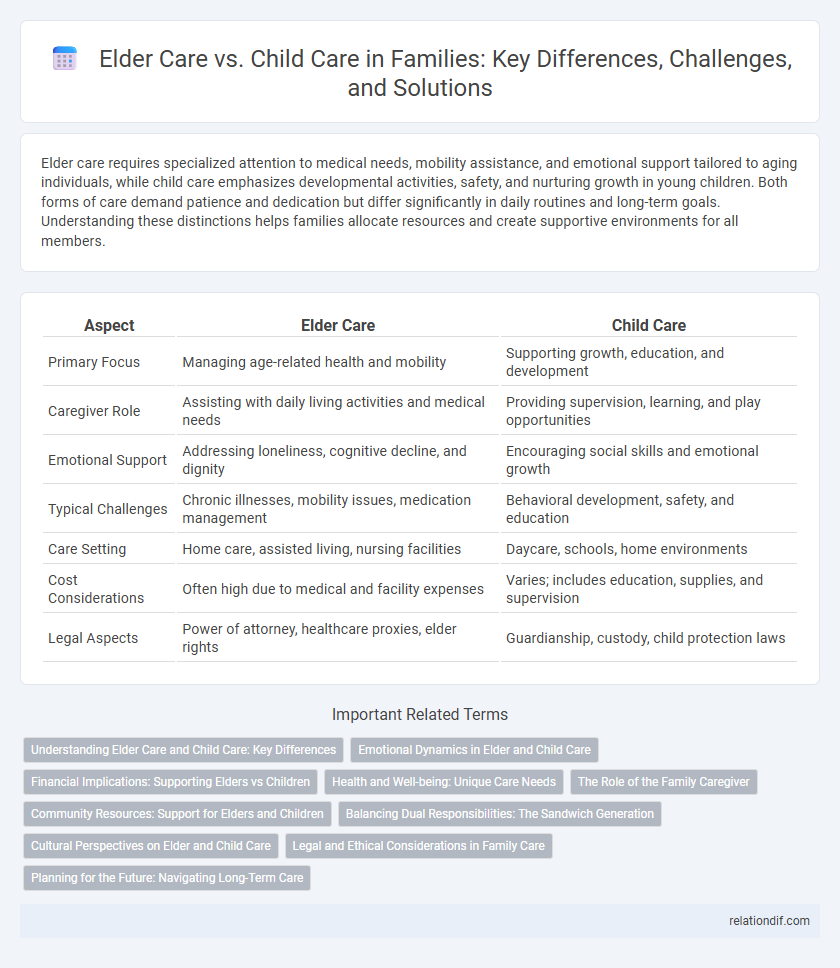Elder care requires specialized attention to medical needs, mobility assistance, and emotional support tailored to aging individuals, while child care emphasizes developmental activities, safety, and nurturing growth in young children. Both forms of care demand patience and dedication but differ significantly in daily routines and long-term goals. Understanding these distinctions helps families allocate resources and create supportive environments for all members.
Table of Comparison
| Aspect | Elder Care | Child Care |
|---|---|---|
| Primary Focus | Managing age-related health and mobility | Supporting growth, education, and development |
| Caregiver Role | Assisting with daily living activities and medical needs | Providing supervision, learning, and play opportunities |
| Emotional Support | Addressing loneliness, cognitive decline, and dignity | Encouraging social skills and emotional growth |
| Typical Challenges | Chronic illnesses, mobility issues, medication management | Behavioral development, safety, and education |
| Care Setting | Home care, assisted living, nursing facilities | Daycare, schools, home environments |
| Cost Considerations | Often high due to medical and facility expenses | Varies; includes education, supplies, and supervision |
| Legal Aspects | Power of attorney, healthcare proxies, elder rights | Guardianship, custody, child protection laws |
Understanding Elder Care and Child Care: Key Differences
Elder care centers on addressing the physical, emotional, and medical needs of aging family members, often requiring specialized healthcare and assistance with daily activities. Child care focuses on nurturing development, education, and safeguarding children's safety and well-being during critical growth stages. Understanding these distinctions helps families allocate resources effectively and ensure tailored support for both elders and children.
Emotional Dynamics in Elder and Child Care
Emotional dynamics in elder care often involve managing feelings of loss, dependency, and dignity, whereas child care centers on fostering security, attachment, and developmental confidence. Caregivers must navigate empathy and patience to address elders' cognitive decline and emotional vulnerability compared to nurturing children's growth and curiosity. Understanding these contrasting emotional landscapes enhances tailored support strategies for both age groups.
Financial Implications: Supporting Elders vs Children
Supporting elders often requires significant financial investment in healthcare, long-term care facilities, and assisted living services, which can rapidly deplete savings. Child care expenses, including education, extracurricular activities, and daily supervision, accumulate over many years but tend to be more predictable and manageable through budgeting. Families must balance immediate elder care costs with long-term child care financial planning to ensure overall economic stability.
Health and Well-being: Unique Care Needs
Elder care requires specialized attention to chronic conditions, mobility challenges, and cognitive health, ensuring tailored medical support and emotional stability. Child care focuses on developmental milestones, immunizations, and creating a safe, nurturing environment to promote physical growth and mental well-being. Both realms demand personalized health strategies emphasizing prevention, regular monitoring, and holistic wellness to support quality of life.
The Role of the Family Caregiver
Family caregivers play a crucial role in providing support for both elder care and child care, addressing unique physical, emotional, and medical needs. In elder care, caregivers often manage chronic conditions, medication, and mobility assistance, while child care involves nurturing development, education, and safety supervision. Effective family caregiving enhances the quality of life and fosters strong intergenerational bonds within the household.
Community Resources: Support for Elders and Children
Community resources provide vital support for both elder care and child care, offering specialized programs such as adult day centers for seniors and after-school activities for children. Local organizations often facilitate access to healthcare services, social engagement opportunities, and educational support, enhancing the well-being of families across generations. Access to these resources reduces caregiver stress and fosters a supportive environment for both elders and children within the community.
Balancing Dual Responsibilities: The Sandwich Generation
The sandwich generation faces unique challenges balancing elder care and child care, often managing the health needs of aging parents while supporting their children's development. Effective time management and access to community resources are crucial for mitigating stress and ensuring both generations receive adequate attention. Technology solutions like telehealth and online tutoring can provide flexible support, helping caregivers maintain productivity and emotional well-being.
Cultural Perspectives on Elder and Child Care
Cultural perspectives significantly shape the approaches to elder care and child care, with many societies prioritizing multigenerational support systems. In collectivist cultures, elder care often involves extended family participation, emphasizing respect and caregiving as a familial duty, while child care typically integrates communal involvement to nurture development. Contrastingly, individualistic cultures tend to rely more on formal institutions for both elder and child care, reflecting different societal values regarding independence and family roles.
Legal and Ethical Considerations in Family Care
Legal and ethical considerations in family care differ significantly between elder care and child care; elder care often involves navigating advance directives, power of attorney, and guardianship issues, while child care focuses on custody, child protection laws, and parental rights. Both require adherence to confidentiality, informed consent, and securing the best interests of the vulnerable family members involved. Understanding statutory regulations and ethical guidelines ensures responsible decision-making and protects the rights and wellbeing of both elders and children within family care settings.
Planning for the Future: Navigating Long-Term Care
Effective planning for the future involves addressing both elder care and child care needs to ensure comprehensive family support. Long-term care strategies include evaluating financial resources, exploring residential and in-home care options, and establishing legal directives like power of attorney and guardianship. Prioritizing open communication among family members promotes coordinated decision-making and emotional preparedness for evolving care responsibilities.
elder care vs child care Infographic

 relationdif.com
relationdif.com